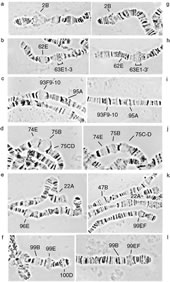
Zhimulev, I.F., E.I. Volkova, and E.S. Belyaeva. 2001. Underdevelopment of late prepupal puffs in mutant l(3)63Ea in Drosophila melanogaster.Dos. Inf. Serv. 84: 1-4.
|
|
|
|||
|
|
||||
Underdevelopment of late prepupal puffs in mutant l(3)63Ea in Drosophila melanogaster.
Zhimulev, I.F., E.I. Volkova, and E.S. Belyaeva. Institute of Cytology and Genetics,
Novosibirsk 630090, Russia; E-mail: zhimulev@bionet.nsc.ru
The l(3)63Ea gene is mapped in the chromosome fragment removed by both Df(3L)GN50 and Df(3L)GN34, but not Df(3L)GN19 (Harrison et al., 1995) which corresponds to the interval 63E6 – 63F6 (Figure 1) on the salivary gland chromosome map according to the revised cytological localization of the break points of the deficiencies (Zhimulev et al., 1998).
| Figure 1. Polytene chromosome map and location of break points of deficiencies in the 63D-64A interval. The chromosome map is drawn according to Bridges (1941); location of the break points is according to Zhimulev et al. (1998). |
Larvae homozygous for the l(3)63Ea mutation grow until the end of the third larval instar, but 50% of them do not form puparium and do not pupariate, i.e. have no spiracle eversion, body shortening, or pigmentation. We did not perform puffing analyses of these larvae. The remaining 50% of larvae pass puparium formation, spiracle eversion, gas bubble formation, and the moulting associated with pupation normally, but then die. Puffing patterns were analysed for this category of mutants.At the stage of puparium formation, puffs in 350 regions were compared with those in normal 0 h prepupa (see Zhimulev and Belyaeva, 1999) and no differences were found (Figures 2 and 3).Similarly, an analysis of puffing patterns in 2-8 h prepupae did not reveal significant differences between Oregon-R laboratory stock and the mutant, except small differences in sizes of puffs 66B and 85D1-2 in 4h prepupae and puffs 34A5-6, 63E1-3, 73EF, 93F9-10 in 8 h prepupae (Figure 3). More dramatic differences were found in 10 h prepupae. At the stage when the prepupal wave of ecdysone inducible puffs appears in wild type animals, nearly all of the ecdysone puffs either fail to appear or are significantly smaller (Figures 3 and 4). Several puffs, which normally disappear in 10 h prepupae, are still active: 34A5-6, 52C4-7, 63D1-2, 63E1-3, 63E1-3’, 69A1-3, 75CD, 85D1-2.
| Figure 2. Parts of the third chromosome of 0 h prepupae with normally developed puffs. |
| Figure 3. (below left) Changes of puffing activity in 31 regions of salivary gland chromosomes during larval and prepupal development (expressed in hours after spiracle eversion). Ordinate: size of puffs in a six class scale. Abscissa: stage of larval (in Puff Stages from 1 to 11) and prepupal development (in hours from spiracle eversion). Solid line – no differences between stocks, dashed line – puffing activity in Oregon-R control stock, dotted line – puffing activity in the l(3)63Ea stock. |
| Figure 4. Late prepupal ecdysone inducible puffs in Oregon-R wild type (a-f) and in mutant l(3)63Ea (g-l). |  |
These data show that the gene l(3L)63Ea+ controls activation of the ecdysone
inducible genes specifically at the time of the late prepupal wave.
Acknowledgments: The authors are very grateful to Dr. Geoff Richards for reading
and comments of the manuscript. The work was in part supported by a grant from
the program “Frontiers in Genetics of Russian Federation”, grants
No. 99-04-49270 and 00-15-97984 from the RFBR program, and grants from Siberian
Division of RAS.
References: Bridges, P.N., 1941, J. Hered. 29: 11-13; Harrison et al., 1995,
Genetics 139: 1701-1709; Zhimulev, I.F. et al., 1998, Dros. Inf. Serv. 81: 209;
Zhimulev, I.F., and E.S. Belyaeva 1999, Dros. Inf. Serv. 82: 9-20.